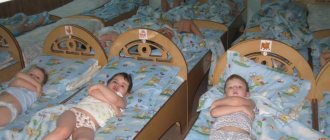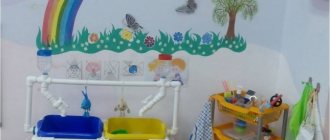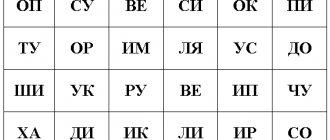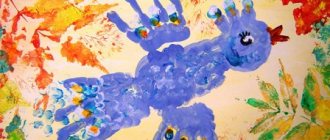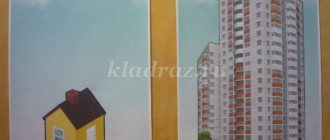Expand the diversity of the educational space with MAAM.
Contained in sections: By groups:
Showing publications 1-10 of 338. All sections | Short-term educational practice. COP in kindergarten
Short-term educational practices
is a short-term
(up to 8 academic hours)
course of joint
educational
activity between a teacher and children, aimed at solving the problems
of the educational
program and resulting in a product of activity or skill...
COP as a means of successful socialization of preschool children COP as a means of successful socialization of preschool children. “Introducing a child into the world of human relationships is one of the important tasks of educating the personality of a preschool child” V.A. Sukhomlinsky. From lat. socialis - social) - 1) the process of assimilation and further development by the individual...
Short-term educational practice in kindergarten using applications. Junior group
Short-term educational practice on broken appliqué “Lessons in unusual creativity”
Developed by: Golubeva Maria Andreevna, Teacher of junior group No. 4 Berezniki, 2021. Short-term educational practice “Lessons of unusual creativity” Brief description of this practice: Developed by teacher: Golubeva Maria Andreevna. Age category of children: 3 – 4 years. Number of participants: up to 12 people. Number of classes: 4. Duration of classes - 20 minutes. The focus of practice is technical. The educational field (FSES) is an artistic and aesthetic field. Relevance
The development of children's creativity is a pressing problem of modern pedagogy and sets the main goal for the education system - to educate the younger generation in a creative approach to transforming the world around them.
We must cultivate in our children inquisitiveness, ingenuity, initiative, imagination, fantasy - that is, those qualities that find vivid expression in children's creativity. Goal: to develop children's artistic creativity in children, using cut-out appliqué as an unconventional form of working with paper. Literature: 1. Maksimova N. M. Kolobova T. G. Application. Educational visual materials for teaching primary preschool age, Moscow, 1998 2. Volchkova V.N., Stepanova N.V. Lesson notes for the second junior group of kindergarten. Voronezh, 2004. Long-term plan for short-term educational practice on cut-out applique “Lessons in unusual creativity” Lesson I Break-out applique “Leaves are falling, falling, leaves are falling in our garden...”
Objectives: To develop children’s ability to create the simplest composition - falling leaves using torn pieces of colored paper ;
development of fine motor skills. Strengthen the skills of smearing pieces of paper with glue and gluing them. To evoke in children an emotional attitude towards natural phenomena. Plan of activities: 1. Admiring the falling leaves from the window. 2. Discussion of leaf color. 3. Demonstration of the technique of tearing colored paper. 4. Show adults how to stick leaves. 5. Independent work of children. 6. Examination of the resulting paintings. Material: 1. Landscape sheets with graphic drawings of trees and bushes without leaves. 2. Colored paper in yellow and orange. 3. Glue 4. Brushes 5. Napkins 6. Illustration of an autumn park Predicted result: Exhibition for parents “Falling Leaves”. Lesson II Tattered applique “Fly agaric”
Objectives: To develop children’s ability to design a fly agaric using torn pieces of paper;
development of fine motor skills. Strengthen the skills of smearing pieces of paper with glue and gluing them. To evoke in children an emotional attitude towards natural phenomena. Plan of activities: 1. Examination of fly agaric mushrooms in pictures. 2. Discussion of the color of the fly agaric. 3. Demonstration of the technique of tearing colored paper. 4. Show adults how to stick white dots. 5. Independent work of children. 6. Review of works. Material: 1. Album sheets with a pattern of a fly agaric with a red hat without white dots. 2. White paper. 3. Glue. 4. Brushes. 5. Napkins. 6. Pictures of fly agarics. Predicted result: Exhibition “Amanitas in the Forest” Lesson III Tattered applique “First Snow”
Objectives: To develop children’s ability to create the simplest composition - snowfall using torn pieces of white paper;
development of fine motor skills. Strengthen the skills of smearing pieces of paper with glue and gluing them. To evoke in children an emotional attitude towards natural phenomena. Plan of activities: 1. Admiring the first snow from the window. 2. Discussion of the color of snowflakes. 3. Demonstration of paper tearing techniques. 4. Show adults how to stick snowflakes. 5. Independent work of children. 6. Examination of the resulting paintings. Material: 1. Sheets of blue cardboard with a graphic design of clouds. 2. White paper. 3. Glue 4. Brushes 5. Napkins 6. Snowfall illustrations. Predicted result: Exhibition of works “First Snow” IV lesson Tattered applique “Painted plate”
Objectives: Develop children’s ability to decorate a plate using torn pieces of paper; development of fine motor skills. Strengthen the skills of smearing pieces of paper with glue and gluing them. Evoke a sense of beauty in children. Plan of activities: 1. Examination of plates with different patterns. 2. Discussion of the color of the pattern. 3. Demonstration of paper tearing techniques. 4. Show adults how to stick snowflakes. 5. Independent work of children. 6. Examination of the resulting paintings. Material: 1. Album sheets with a graphic image of a plate. 2. Colored paper. 3. Glue 4. Brushes 5. Napkins 6. Plates with different images of patterns. Predicted result: Exhibition of works “Plates”
Appendix
I Lesson Break-out applique “Leaves are falling, falling, leaves are falling in our garden...”
Lesson II: Disruptive applique “Fly agarics”
Lesson III: Cut-out applique “First snow”
Lesson IV: Broken applique “Painted plate”
We recommend watching:
Application from paper napkins for children on the theme of Winter Application on the theme of Spring for kindergarten. Junior group Lesson notes for the 2nd junior group. Autumn applique DIY applique on the theme: Spring for older children
Similar articles:
Application for children 2-3 years old. Umbrella
Why is a technical COP needed in a preschool educational institution?
Short-term construction practice is very important for children, especially five-year-olds. By creating his own project, the child learns synthesis and analysis, which is so necessary for learning at school. While examining the sample, the preschooler comes up with a new design for it and learns to correct the mistakes made. Such training perfectly stimulates the development of thinking. Games with Lego constructors can be started from the middle group.
Such material will help solve many problems and problems in the development of preschoolers. It must be included in the arsenal of technical-oriented educational programs in preschool educational institutions. “Lego” not only helps develop color perception, logic and spatial imagination, but also activates finger tenacity. The child will not get bored with this construction set, because with its help you can create thousands of different crafts. Preschoolers really appreciate this variety.
What tasks does the COP solve in a preschool educational institution?
CEP technical orientation in preschool educational institutions, carried out in preschool institutions, allows you to solve the following problems:
- Educational - children learn various design techniques.
- Developmental - children train logic and thinking, imagination and fine motor skills.
- Educational - the technique allows you to instill perseverance, determination, and patience in a preschooler.
The work can use the methods of observation, examination, demonstration, verbal method and the method of plot games.
All of them are equally effective, but an important condition for the lesson is a well-thought-out plot and positive motivation.
In technical design classes, children create crafts based on real-life objects or fantasize about fairy tales, poems or songs.
KOP article in the junior group Playing with sand. Author: Yastrebova Maria Ivanovna
Short-term educational practice (SEP)
in the junior group “Sand Games”
Relevance
Playing with sand for children at a very early age is their first creative activity, allowing them to show invention, creativity and imagination. Such games, in accordance with the stage of development of the child, involve performing a variety of play actions: joint actions of an adult and a child; actions of imitation and in the image proposed by an adult; independent actions reflecting the child’s own ideas. According to psychologists, it relieves children's irritability, aggressiveness, tearfulness and at the same time rapidly develops imagination, has a positive effect on the emotional state of children and is an excellent means for development and self-development.
Goal: development of fine motor skills and communication skills, creativity, ability
cooperate with each other, playing together..
Tasks:
— introduce children to the properties of sand;
— to intensify children’s interest in experimenting in the sandbox;
— develop fine motor skills of the hands, children’s speech, hand-eye coordination.
Expected results:
Age: children 3-4 years old (second youngest group)
Implementation period: September - May
Lesson duration: 10 minutes.
Forms and mode: Individual and subgroup meetings for 10-15 minutes in the evening.
Expected Result:
-Stabilize the psycho-emotional state
-Improve coordination of movements, finger motor skills
- Stimulate the development of sensory, tactile-kinesthetic sensitivity
-Develop communication skills and speech, spatial orientation
-Stimulate cognitive interests and broaden horizons.
Material: spatulas, sieves, funnels;
• various plastic molds of different
• miniature Kinder Surprise toys;
• waste material: pebbles, shells, twigs, sticks, large buttons, disposable cocktail straws.
| Month | Subject | Target |
| September | Hello sand! | reduce psychophysical stress, consolidate knowledge about the properties of sand. The teacher asks the children to say hello to the sand in different ways, without repeating the actions of the other: - touch the sand with the fingers of one hand, then the other, then both hands at the same time; - at first lightly, then with tension, clench your fists with sand and slowly pour it into the sandbox; - touch the sand with your entire palm; - rub the sand between your palms. Then the children describe what sensations they had: warm, cold, rough sand, wet, dry, etc. |
| Little explorer | introduce a component of inanimate nature - dry sand. Children examine a small handful of dry sand on a sheet of white or black paper. The teacher offers to look at the sand through a magnifying glass and touch it. Then he asks the children questions (you can make the task more difficult): — What color is the sand? (You can have the children choose the appropriate colors from a box of crayons.) - Tell us about a grain of sand (you can come up with several fairy tales about sand and grains of sand with your children). — Does sand fall easily? Show the children and give them the opportunity to pour a handful of sand from sheet to sheet, from the palm of their hand into a mold, etc. | |
| October | Games in the sand. | Develop fine motor skills of the hands, children's speech, and visual-motor coordination. The teacher asks the children about the game of hide and seek, whether they like it or not. And he offers to play hide and seek in the sandbox, hiding the toys. First the teacher hides it, and then the one who finds it. You can help in finding the “treasure” with the following words: cold, hot, warm. |
| Game “I bake, bake, bake” | acquaintance with the properties of sand, development of coordination of movements, hand motor skills. Contents: The child “bakes” buns, pies, and cakes from sand. To do this, the baby can use a variety of molds, pouring sand into them, compacting them with his hand or a scoop. You can also “bake” pies with your hands, transferring wet sand from one palm to another. Then the child “treats” the pies to the dolls. | |
| Game "Magic fingerprints on the sand" | familiarization with the properties of sand, development of coordination of movements Contents: The teacher and the child leave prints of their hands and feet on the wet sand, and then complete them or add pebbles to create funny faces, fish, octopuses, birds, etc. | |
| November | Patterns in the sand | develop creative imagination, consolidate sensory standards. The teacher shows the children what and how they can draw on the sand: with a brush, a stick, a finger, a stream of water, they can lay out patterns with pebbles, buttons. Let's draw flowers on the sand with a stream of water. From a small watering can, children water the sand, forming petals, a center, a stem, and leaves. The teacher offers stories and helps children draw in the sand in different ways. |
| Prints | teach to perform actions in accordance with verbal instructions. Molds depicting animals, flowers, transport, geometric shapes, etc. are used. The teacher and children take turns making prints in the wet sand. Then each child, following verbal instructions, makes a series of prints, commenting on the process: “I’ll take a mold with a typewriter, pick up sand, knock, and turn it over.” | |
| Car roads | Teach children to rake sand and make holes (tunnels for a highway). To develop children's road literacy. The teacher asks riddles about cars. He suggests telling the children a quatrain on the topic: “Traffic lights” and traffic. Next, the teacher invites the children to play road builders, showing how to build tunnels and smooth out sections of the road. After construction, the children all play together. | |
| December | Sand rain | regulation of muscle tension, relaxation. A teacher in the image of a “sand fairy”: in a cap with a golden pattern, with a bucket, different molds |
| Cartoon hero. | Introduce children to the properties of sand (wet-dry). Get children interested in creating collaborative work. Develop interest in sandbox games. The teacher tells the children about the properties of sand. The teacher tells the children where sand is used. Invites children to split into pairs and make cartoon characters out of raw sand. | |
| Sand fairy. | My country is all made of sand, there can be unusual sandy rain and sandy winds blowing in it. Let's see how this happens. Children gradually, speeding up the pace, pour sand from their fist into the sandbox, into a mold, into their palm, into the palm of an adult. Children sit with their eyes closed, placing their palms on a sheet of sand. The teacher sprinkles sand on some finger, and the child names it. The teacher plays with each child. | |
| Hints | teach ordinal counting. The teacher makes several sand cakes, in one of which a toy is hidden. (prompts). A toy in the fifth Easter cake. A toy between the third and fifth Easter cakes. Thus, the teacher encourages the child to count and look for a toy. The game is played with each of the children. | |
| January | Cure the letter | study letters with children, introduce them to their writing. The teacher shows the children the letters of the alphabet, then draws them in the sand and erases some part. Invites each of the children to “cure” a letter and complete the missing part. |
| "Pour dry sand through a funnel" | Introduce children to the properties of dry and wet sand. The teacher leads a group of children to the sandbox. Hands out bottles, buckets, and molds to children. Shows how sand is poured through a funnel, how it is poured from a bucket into a mold. Then he pours some of the sand, mixes it with a scoop and shows that wet sand cannot be poured, but it can be sculpted into different shapes. The teacher shows the children how to fill the mold, press the sand with their fingers or a scoop, tip the mold onto the side of the sandbox, and decorate the “pie” or “cake.” | |
| February | Tops and roots | develop attention, observation, memory. An adult names a vegetable, and the children quickly answer what is edible in it. If there are roots, they hide their hands in the sand, and if they are tops, they place their fists on the surface of the sand. (Carrots, tomatoes, onions, cucumbers, radishes, turnips, zucchini, potatoes, beets, peas). |
| "I have found" | An adult buries a toy in the sand, and the child must recognize and name the toy by touch. | |
| Experimental activities. “What is sand made of?” | Goal: Find out what sand is made of. Materials: cups of sand, sheets of white paper, magnifying glasses. Description:Pour sand onto a piece of paper and examine it with a magnifying glass. What is sand made of? (grains of sand). What do grains of sand look like? Are grains of sand similar to each other? Conclusion: Sand consists of small grains of sand that do not stick to each other. | |
| March | "Warm - cold" | Goal: to teach children to feel the different temperatures of sand with their hands. Material: bags of warm and cold sand. Description: Give the children warm and cold sand, check which sand is which. Offer to play with sand. Which sand was more pleasant to play with? Conclusion: It is more pleasant to play with warm sand. |
| "Dry sand" | Purpose: to introduce children to the properties of sand. Material: sandbox, dry sand, molds. Description: Offer to make Easter cakes from dry sand. They didn’t work out, they fell apart. Why? Conclusion: dry sand is free-flowing. | |
| “Let’s make Easter cakes” | Purpose: to highlight the properties of wet sand. Material: sand, water. Description: Invite your child to look at the sand. Is it possible to sculpt from sand? Try making Easter cakes from dry sand. Why doesn't it work? Let's try to mold it from wet. Conclusion: you can make Easter cakes from wet sand. | |
| April | "Where did the water go" | Purpose: to show that sand easily absorbs water. Material: cups with sand and water. Description: Pour water into a glass of sand. Touch the sand. What has he become? Where did the water go? Conclusion: water is quickly absorbed into the sand. |
| "Building towers" | Teach children to make towers by pouring sand on top, handle sand carefully, compare towers by height, and use appropriate vocabulary. | |
| May | Game "A Stream Flows" | development of tactile sensitivity, relaxation, activation of interest, familiarization with the properties of sand. Content. In the sandy country it sometimes rains, and real rivers and lakes appear. Want to see how it happens? An adult pours water onto one part of the sand in a thin stream from a jug. |
| Game "Sow, Sow" | development of tactile sensations. Introduction to the properties of sand. Content. The teacher shows how to sift sand through a sieve. The game will become more interesting if, while sifting through the sand, the child finds small toy figures (for example, from Kinder Surprise). |
Drawing up a technological map by the teacher
Before starting work on the program, the teacher must create a technological map of the COP of a technical focus in the preschool educational institution. It is compiled very simply. To begin, select the name of the activity, for example “Spaceship”, “Merry Men”, “Butterflies”. Indicate the age of the children, the duration of the practice, its tasks, and goals. The resources used and the desired result also need to be included in the map. The last thing that needs to be indicated is what key competencies will be developed in children during the CEP of a technical focus in a preschool educational institution.
An example of such competencies:
- technological - learning to assemble a dog, learning to assemble a car according to a diagram, learning to connect elements into a whole model;
- informational - learn to choose material for work, learn to choose non-standard material for creativity, learn to use information when working with other materials;
- social-communicative - learn to speak correctly with peers and adults, learn to interact with peers.
